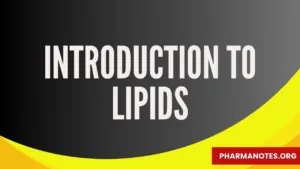Introduction to lipids

Objective
• At the end of this lecture, student will be able to
– Explain lipids
– Classify lipids
– Describe the properties of lipids
– Discuss the tests to check purity of fats and oils
Introduction to Lipids
Definition: Lipids can be regarded as organic substances relatively insoluble in water, soluble in organic solvent, actually or potentially related to fatty acids and utilized by living cells
Functions of lipids
• They are the fuel reserve of the body (triacylglycerols)
• Lipids are the constituents of membrane structure and regulate the membrane permeability (phospholipids and cholesterol)
• They serve as a source of fat soluble vitamins (A, D, E and K)
• Lipids are important as cellular metabolic regulators (steroid hormones and prostaglandins
• Lipids protect the internal organs, serve as insulating materials and give shape and smooth appearance to the body
Classification to lipids
Lipids are broadly classified in to simple, complex, erived and miscellaneous lipids
1. Simple lipids: Esters of fatty acid with alcohol. 2 types,
I. Fats and oils: Esters of fatty acid with glycerols. The difference is fats are solid and oils is liquid by physical state
II. Waxes: Esters of fatty acid with alcohol other than glycerols.
2. Complex lipids: these are esters of fatty acid with alcohols containing additional groups such as phosphate, nitrogen base, proteins, carbohydrates etc. further divided into
I. Phospholipids: In addition to fatty acid and alcohol, they contains phosphoric acid and nitrogen base – 2 types
a) Glycerophospholipids: They contain glycerol as alcohol e.g. Lecithin, Cephalin
b) Sphingophospholipids: They contain sphingosine as alcohol e.g. Sphingomyelin
II. Glycolipids: These lipids contain a fatty acid, carbohydrate & nitrogen base. The alcohol is sphingosine, hence, they are also called glycosphingolipids e.g. Cerebrosides, gangliosides
III. Lipoproteins: the complex of lipids with proteins
IV. Other complex lipids: Sulfolipids, amino lipids etc
3. Derived lipids: these are the depravities obtained on the hydrolysis of group I and group II lipids which possess characteristics of lipids, They include mono and diacylglycerols
4. Miscellaneous: A large number of compounds possess the characteristics of lipids e.g. Carotenoids, Terpenes etc
5. Neutral lipids: Uncharged Lipids are referred as neutral lipids. e.g. Mono, di and tri-glycerols, cholesterol and cholesterol ester
Fatty acid – carboxylic acid with hydrocarbon side chain and simplest form of lipids
Classification of Lipids based on saturation
• Saturated fatty acids do not contain double bonds, while unsaturated fatty acids contain one or more double bonds
• Both saturated and unsaturated fatty acids almost equally occur in the natural lipids
• Fatty acids with one double bond are monounsaturated and those with 2 or more double bonds are collectively known as polyunsaturated fatty acids (PUFA)
• Saturated fatty acids end with a suffix -anoic (e.g., octanoic acid) while unsaturated fatty acids end with a suffix- enoic (e.g., octadecanoic acid)
Classification of Lipids based on essential and non-essential fatty acid
• The essential fatty acid are Linoleic acid and Linolenic acid and other are non-essential fatty acid
Properties of Triacylglycerols
• Triacylglycerols (formerly triglycerides) are the esters of glycerol with fatty acids
1. Hydrolysis: It undergo stepwise enzymatic hydrolysis to finally liberate free fatty acids and glycerol, catalysed by lipases
2. Saponification: The hydrolysis of triacylglycerols by alkali to produce glycerol and soaps is known as saoonification
3. Rancidity: Rancidity is the term used to represent the deterioration of fats and oils resulting in unpleasant taste. Fats containing unsaturated fatty acids are more susceptible to rancidity. Rancidity occurs when fats and oils are exposed to air, moisture, light, bacteria etc
4. Antioxidants: The substances that can prevent oxidative rancidity are known as antioxidants. Trace amounts of antioxidants such as tocopherols (vitamin E), etc are added to commercial preparations of fats and oils to prevent rancidity
5. Lipid peroxidation in vivo: In the living cells, lipids undergo oxidation to produce peroxides and free radicals which can damage the tissue
Tests to check the purity of fats and oils
• Adulteration of fats and oils is increasing day by day. Several tests are employed in the laboratory to check the purity of fats and oils
lodine number:
• Defined as the grams of iodine absorbed by 100g of fat or oil.
• Lower is the iodine number, less is the degree of unsaturation
• Determination of iodine number will help to know the degree of adulteration of a given oil
Saponification number:
• Defined as the mg of KOH required to hydrolyse (saponify) one gram of fat or oiL
• Saponification number is a measure of the average molecular size of the fatty acids present
• The value is higher for fats containing short chain fatty acids
• Human fat: 195-200
• Butter: 230-240
• Coconut oil: 250-260
Acid number:
• Defined as the number of mg of KOH required to completely neutralize free fatty acids present in one gram fat or oil.
• In normal circumstances, refined oils should be free from any free fatty acids.
• Oils, on decomoposition-due to chemical or bacterial contamination-yield free fatty acids. Therefore, oils with increased acid number are unsafe for human consumption
Summary
• Lipids can be regarded as organic substances relatively insoluble in water, soluble in organic solvent, actually or potentially related to fatty acids and utilized by living cells
• They are the fuel reserve of the body
• Lipids are broadly classified into simple, complex, derived and miscellaneous lipids
• The essential fatty acid are Linoleic acid and Linolenic acid and other are non-essential fatty acid
• Iodine number, saponification number and acid number are used to check the purity of oils and fats
Also, Visit:
B. Pharma Notes | B. Pharma Notes | Study material Bachelor of Pharmacy pdf


